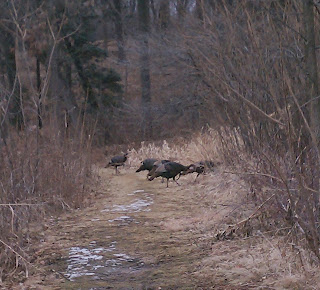I ran into these three turkeys while out for a walk in one of Madison, WI city parks. Only thing was they were not alone. THEY JUST KEPT COMING! All told there were 16 turkeys lurking in the woods. I did my best to give them their space, but wherever I went they were pretty close behind. I zigzagged they zigzagged, I turned around and jogged back down the trail they jogged down the trail after me.
Now most people I know would not be worried by this, but me I'm scared of turkeys. You might say it is an irrational fear, but have you ever seen the spikes on the back of a turkey's leg?
Males use these formidable spikes to injure or kill other male turkeys during mating season. So imagine a large 6-24 pound turkey flying at your head with spikes a blazing, scary thought am I right? Did I mention they can fly at speeds of up to 54 miles an hour?
The coolest fact I know about turkeys is using their gizzard they can crush 24 English walnuts at once. The gizzard is a small muscular pouch in the turkey's neck which helps to break up their food into smaller pieces for digestion. This pouch often has small rocks or pebbles in it to help crush anything in it.
While the wild turkey's domestic cousin maybe fairly dumb, if you watch a group of wild turkeys you'll find they can be fairly inquisitive. Joe Hutto’s book and also the Nature documentary he talks about his experiences raising wild turkeys and watching their inquisitive nature. While I am not advocating adopting wild animals the documentary makes for interesting watching.
Keep your eyes peeled the next time you take a walk in the woods for smart, fast flying, spike caring heavy birds! Just watch out for your head.











